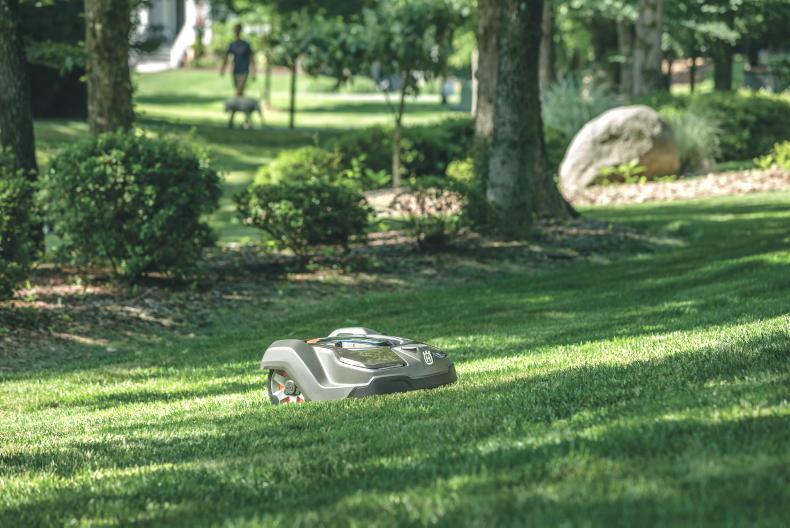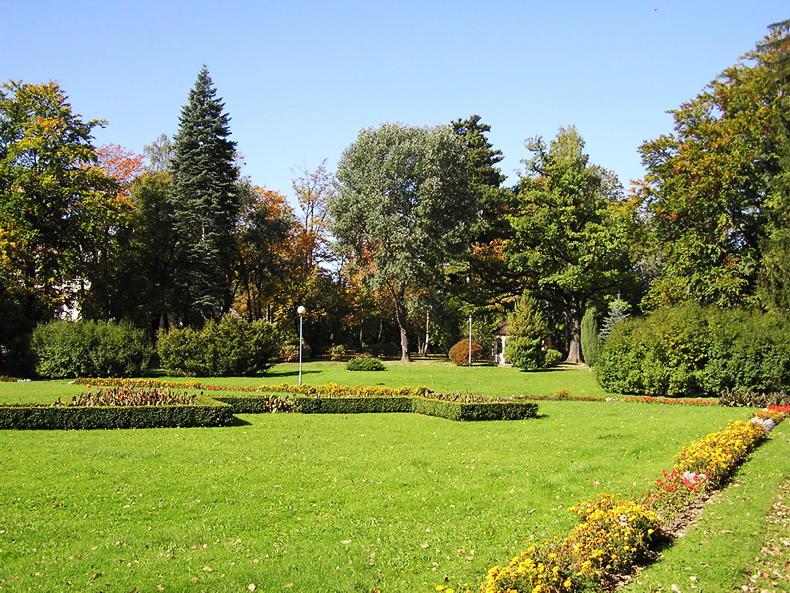Regardless of what type of lawn you are deciding to grow, you are going to need a lawnmower at some stage to keep in control of your grass.
For those who still have their same trusty mower in the shed then recommendations are to get your blades sharpened two to three times a year if you are a regular grass cutter. The blunter the blade the more chance of the grass being hauled up by the root which you don’t want.
If you are looking to change your mower to something more environmentally friendly, electric or battery-powered mowers are a better option. Battery-powered automatic mowers will save you running cables from the house or the garage and can take the chore of grass cutting right out of your hands explains Andy Walsh, service manager with Liffey Distributors Ltd.
“We sell the biggest-selling robotic lawnmower in the country, in fact, in the world, the Husqvarna Automower,” says Andy.

A Husquvarna Automower.
“They are battery powered, have no emissions, don’t make any noise and actually clip the grass. As opposed to what we generally do when we use rotary lawnmower and tractors where we’re whipping the grass.”
Because the automatic lawnmowers are clipping the grass more often, you can basically set it up to cut as often as you like, the pieces are so small that they just fall back into the root of the grass. It handles all the work so you can just sit back, relax and never have to remove grass stains from your clothes again.
Lawn maintenance with a mulching mower
The biggest mistake people make when cutting their lawn is cutting it too low. Granted you won’t have to cut it so often, but you are actually destroying your lawn. When you’re removing clumps of moss from your lawn and wondering where it all went wrong, this is why.
“We use a type of lawn maintenance called grass cycling,” says Betty Kehoe of Aisling Designs.

Betty Kehoe of Aisling Designs.
“As the name suggests, it’s the recycling of the lawn clippings.”
“It just involves having a very sharp blade on your mulching mower. You cut one-third of the grass height, so you don’t shave the grass. When you finish the grass should be at least three inches tall.”
“If you cut weekly using a well-serviced mulching mower and you are only topping the grass once a week, the mower will mulch it up and blow it back down to the base of the grass,” she says.
If you are worried about grass being dragged into the house on someone’s feet, that shouldn’t happen if you leave the grass over three inches. Never go below.
It’s worth pointing out that you can make your fuel-operated lawnmower more efficient with this method as you are not dragging around a heavy bag of grass on the mower as you cut.
“This method is building up a little bit of thatch in the lawn so you will have to water less, and feed less because you are not cutting the nutrients off,” says Betty.
To cut or not
There is no hard and fast rule that you have to cut your lawn and in Betty’s experience of landscaping rural gardens she finds that the perfectly manicured lawn may not be achievable, so you should work with what you’ve got.
“You are going to have grass seeds blowing in -and weed seeds blowing in so what I think is people should look away from cutting or shaving to try to achieve the perfect lawn in the countryside,” she says.
“Maybe cut certain areas and let certain areas go a little bit wilder.

If you have huge areas of lawn, consider planting trees and make the garden more interesting by having a little copse area.
“If you have huge areas, consider planting trees and make the garden more interesting by having a little copse area. You could let the lawn grow into a wildflower meadow and just mow some winding paths through it,” she suggests.
“Let the grass work for you, don’t feel that you have to control it,” she adds.
If you are the type of person who gives out about “having” to cut the grass again then maybe these options are for you. Less work in the garden gives you more play.
Wildflower lawns
Wildflower lawns are becoming increasingly popular and they can come in all shapes and sizes. Whether you have a dedicated area to plant seed or are just letting the lawn grow and watching what happen, the bees and the environment will thank you for it.
Chances are you have dormant seed lying in your grass just waiting for their time to shine.
Justin Ivory is a biodiversity advocate who converted his own lawn a few years ago. He says that the advice on growing a wildflower meadow or lawn in the past has now changed. Before it was focused on planting meadows with new seed but not all species were native to Ireland so there is a new approach.
“The recommended thinking now is a reduced cutting regime, either on half of your lawn, or your whole lawn, whichever you choose to do,” says Justin.
“You might only cut once a year, it could be cut three times a year, or the recommended way is to cut every maybe six to eight weeks.”
“Different plants flower at different times in the season, so depending on when you cut, different flowers may come through.”
“The two rules they say are: try and avoid your first cut until mid-April and always remove the grass cuttings because those grass cuttings enrich the soil and wildflower actually like poor soil,” he explains.
If you are worried about the “untidiness” of it all then be sure to cut a nice edge on the area you are intending to grow to tidy it up a little.
“When you cut an edge on it, it actually looks deliberate and looks quite neat,” he adds.
Bigger areas can have pathways cut through them as Betty already suggested.
Seed library/ark
If you are interested in planting seeds in your lawn to create a wildflower lawn, then perhaps getting involved with your nearest Seed Library or Ark is for you.
For example, Bray library in Co. Wicklow has a Seed Ark which is “a self-sustaining collection of open pollinated or heirloom seeds that is free for the community to use”.
You can “borrow” the seeds from the library during the planting season provided at the end of the season, you return with some seeds saved from the plants you grew.
It’s a fantastic resource and there are similar initiatives all around Ireland, just check in with your local biodiversity groups for recommendations.
It’s also a wonderful activity to get the kids involved in. A fascinating way to teach them about biodiversity and the lifecycle of plants.
Read more
The man behind the perfect pitch
A sanctuary of soil
Regardless of what type of lawn you are deciding to grow, you are going to need a lawnmower at some stage to keep in control of your grass.
For those who still have their same trusty mower in the shed then recommendations are to get your blades sharpened two to three times a year if you are a regular grass cutter. The blunter the blade the more chance of the grass being hauled up by the root which you don’t want.
If you are looking to change your mower to something more environmentally friendly, electric or battery-powered mowers are a better option. Battery-powered automatic mowers will save you running cables from the house or the garage and can take the chore of grass cutting right out of your hands explains Andy Walsh, service manager with Liffey Distributors Ltd.
“We sell the biggest-selling robotic lawnmower in the country, in fact, in the world, the Husqvarna Automower,” says Andy.

A Husquvarna Automower.
“They are battery powered, have no emissions, don’t make any noise and actually clip the grass. As opposed to what we generally do when we use rotary lawnmower and tractors where we’re whipping the grass.”
Because the automatic lawnmowers are clipping the grass more often, you can basically set it up to cut as often as you like, the pieces are so small that they just fall back into the root of the grass. It handles all the work so you can just sit back, relax and never have to remove grass stains from your clothes again.
Lawn maintenance with a mulching mower
The biggest mistake people make when cutting their lawn is cutting it too low. Granted you won’t have to cut it so often, but you are actually destroying your lawn. When you’re removing clumps of moss from your lawn and wondering where it all went wrong, this is why.
“We use a type of lawn maintenance called grass cycling,” says Betty Kehoe of Aisling Designs.

Betty Kehoe of Aisling Designs.
“As the name suggests, it’s the recycling of the lawn clippings.”
“It just involves having a very sharp blade on your mulching mower. You cut one-third of the grass height, so you don’t shave the grass. When you finish the grass should be at least three inches tall.”
“If you cut weekly using a well-serviced mulching mower and you are only topping the grass once a week, the mower will mulch it up and blow it back down to the base of the grass,” she says.
If you are worried about grass being dragged into the house on someone’s feet, that shouldn’t happen if you leave the grass over three inches. Never go below.
It’s worth pointing out that you can make your fuel-operated lawnmower more efficient with this method as you are not dragging around a heavy bag of grass on the mower as you cut.
“This method is building up a little bit of thatch in the lawn so you will have to water less, and feed less because you are not cutting the nutrients off,” says Betty.
To cut or not
There is no hard and fast rule that you have to cut your lawn and in Betty’s experience of landscaping rural gardens she finds that the perfectly manicured lawn may not be achievable, so you should work with what you’ve got.
“You are going to have grass seeds blowing in -and weed seeds blowing in so what I think is people should look away from cutting or shaving to try to achieve the perfect lawn in the countryside,” she says.
“Maybe cut certain areas and let certain areas go a little bit wilder.

If you have huge areas of lawn, consider planting trees and make the garden more interesting by having a little copse area.
“If you have huge areas, consider planting trees and make the garden more interesting by having a little copse area. You could let the lawn grow into a wildflower meadow and just mow some winding paths through it,” she suggests.
“Let the grass work for you, don’t feel that you have to control it,” she adds.
If you are the type of person who gives out about “having” to cut the grass again then maybe these options are for you. Less work in the garden gives you more play.
Wildflower lawns
Wildflower lawns are becoming increasingly popular and they can come in all shapes and sizes. Whether you have a dedicated area to plant seed or are just letting the lawn grow and watching what happen, the bees and the environment will thank you for it.
Chances are you have dormant seed lying in your grass just waiting for their time to shine.
Justin Ivory is a biodiversity advocate who converted his own lawn a few years ago. He says that the advice on growing a wildflower meadow or lawn in the past has now changed. Before it was focused on planting meadows with new seed but not all species were native to Ireland so there is a new approach.
“The recommended thinking now is a reduced cutting regime, either on half of your lawn, or your whole lawn, whichever you choose to do,” says Justin.
“You might only cut once a year, it could be cut three times a year, or the recommended way is to cut every maybe six to eight weeks.”
“Different plants flower at different times in the season, so depending on when you cut, different flowers may come through.”
“The two rules they say are: try and avoid your first cut until mid-April and always remove the grass cuttings because those grass cuttings enrich the soil and wildflower actually like poor soil,” he explains.
If you are worried about the “untidiness” of it all then be sure to cut a nice edge on the area you are intending to grow to tidy it up a little.
“When you cut an edge on it, it actually looks deliberate and looks quite neat,” he adds.
Bigger areas can have pathways cut through them as Betty already suggested.
Seed library/ark
If you are interested in planting seeds in your lawn to create a wildflower lawn, then perhaps getting involved with your nearest Seed Library or Ark is for you.
For example, Bray library in Co. Wicklow has a Seed Ark which is “a self-sustaining collection of open pollinated or heirloom seeds that is free for the community to use”.
You can “borrow” the seeds from the library during the planting season provided at the end of the season, you return with some seeds saved from the plants you grew.
It’s a fantastic resource and there are similar initiatives all around Ireland, just check in with your local biodiversity groups for recommendations.
It’s also a wonderful activity to get the kids involved in. A fascinating way to teach them about biodiversity and the lifecycle of plants.
Read more
The man behind the perfect pitch
A sanctuary of soil









 This is a subscriber-only article
This is a subscriber-only article









SHARING OPTIONS: